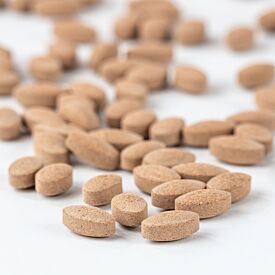Create a Pitta-Balancing Daily Routine
Establishing a supportive daily routine is a crucial part of the Ayurvedic lifestyle, and it can be especially helpful when pitta is provoked. Our physiology is very much adapted to—and supported by—a sense of routine. Excess pitta tends to increase the level of fire and intensity in the system, and a daily routine naturally introduces a calm, grounding energy that can serve to disrupt the cycles of stress and busy-ness that have become the norm for so many of us. If we tailor our routine to pacify pitta, the benefits become even more impactful.
It’s important to note that following an Ayurvedic daily routine does not mean that you should schedule every moment of every day. Instead, it’s about creating consistency with a handful of habits that are repeated each day at similar times. This invites the body to relax into a sense of normalcy, grace, and ease. While the traditional Ayurvedic daily routine could easily require several hours, we recommend that you start with a few simple commitments—things like going to bed and getting up at the same times each day, eating three meals at roughly the same times daily, and pampering yourself with one or two quiet, nourishing practices that calm the mind and soothe pitta’s intensity. Below, you’ll find a number of ideas and suggestions. They are nothing more. Please keep it simple at first. You can always expand your routine once the initial elements become second nature to you.

Your Evening Routine
Where pitta is concerned, prioritizing rest matters, so focusing on your evening habits is always a useful starting point. And in truth, a successful daily routine begins the night before. Choosing to be intentional about the flow of your evening ensures that you are grounded at the end of your day, that you get enough rest, and that you sleep as soundly as possible.
Create an Evening Self-Care Ritual
A sense of routine can be built around even the most mundane aspects of the day. What makes a routine distinct is that we do it consistently and use it as a means of reminding our bodies that all is well, that we are safe, and that we can relax. To this end, take a few minutes to pamper yourself before bed. Doing so has the potential to bolster your sense of well-being, and will likely improve the quality of your sleep as well.
Your evening ritual need not be complicated. In fact, it will most likely consist of hygiene and self-care practices that are already quite familiar to you. Still, the more you can embrace a sense of ritual, and infuse it with nurturing self-love, the better. Be mindful of keeping your ritual simple and doable—especially at first—and follow your own inner guidance around what to include. Consider any or all of the following, alongside any additions that would feel luxurious and relaxing to you:
- Take triphala. About half an hour before bed, take 2 Triphala tablets to nourish and rejuvenate the tissues, support the body’s natural detoxification mechanisms, and to encourage proper digestion and elimination.
- Brush your teeth. Ayurveda emphasizes the importance of good oral hygiene, which Western medicine has firmly linked to our overall health.
- Floss your teeth. Evening is a great time for this daily oral hygiene essential.
- Wash your face. Make this an act of love and devotion to yourself.
- Apply moisturizer to your face, body, or both. Remember not to rush through your practices, but to do them with deep reverence.
- Massage your feet, scalp, or both with oil. This Ayurvedic practice helps to calm the mind and ground the energy before sleep. You may use the herbal oil included in your bundle recommendation.
- Practice Bhramari Pranayama. This yogic breathing practice calms both the mind and the body. It can also help to support sound and easeful sleep. Even five minutes can have a tangible impact.
Honor an Early Bedtime
Next, choose a bedtime and stick with it as best you can. Consider a commitment to retire before 10 p.m. as a way of discouraging pitta’s tendency to be productive late at night. While the night-owl in you might enjoy the fruitfulness of night-time work sessions, staying up late tends to be more disruptive than helpful for pitta, especially when it comes to our circadian rhythms. Ultimately, receiving adequate rest will help to pacify pitta. If you have an intention to awaken especially early on a regular basis, you might consider working backwards from that time to establish an appropriate bedtime—budgeting a minimum of seven hours for sleep.
If you tend to have trouble quieting your mind or falling asleep, you will find additional resources and suggestions in our guide to Balancing Insufficient Sleep.

Your Morning Routine
The first step in creating a morning routine is to choose a consistent time to wake up. Because rest is important, it may be helpful to give yourself permission to sleep later than you normally might if your schedule requires you to stay up late, or if your bedtime routine is disrupted for some reason. Otherwise, pitta does best to awaken early in the morning—ideally by or before 6 a.m.
Morning Hygiene
Upon waking, it is best to begin the day by taking care of your personal hygiene. We’ve included the most pitta-pacifying Ayurvedic hygiene practices below. But remember, you do not have to commit to doing all of them.
- Eliminate. Ayurveda recommends that we eliminate upon waking every day. If you are not already in the habit of having a bowel movement first thing each morning, simply relaxing on the toilet for a few minutes can encourage the body to develop a sense of regularity. Cleaning the tongue and drinking warm water (see below) will also support this habit.
- Clean your tongue. In Ayurveda, scraping your tongue with a metal Tongue Cleaner is considered as indispensable as brushing your teeth. Doing so gently cleanses and awakens the digestive system for the day. It also removes accumulated toxins and bacteria from the tongue that can contribute to foul-smelling breath. If you are new to this practice, please see our resource on How to Clean Your Tongue.
- Brush your teeth. Again, good oral hygiene is intricately linked to our overall health. Take your time with this practice, and be gentle.
- Swish with oil. Oil pulling is an ancient Ayurvedic practice that helps to nourish and rejuvenate the teeth and gums, loosen plaque from the teeth, balance oral bacteria, and relax the muscles of the neck and jaw. You may use our specialized oil pulling formula, Daily Swish, which is a cleansing and refreshing herbal oil blend. If you are new to this practice, please see our resource on How to Do Oil Pulling.
- Drink warm water. Drinking 1–4 cups of warm (or hot) water after your oral hygiene routine helps to stimulate and gently awaken the digestive tract, hydrate the tissues, and also promotes peristalsis—which can encourage a healthy morning bowel movement.
A successful and supportive daily routine is all about consistency and finding what is feasible for you. After all, this is your routine! Try integrating one new practice every week, building your daily routine over time. Use this weekly check list to get inspired and help you stick to your goals, but remember to stay flexible and listen to the needs of your body.
Morning Nourishment
Even more important than your morning hygiene practices is the energy with which your day begins. Taking a few minutes of quiet time to get the day off to an intentional and grounded start can literally change your life. This is an extensive list of suggestions, but again, the idea is not necessarily to do all of them. In fact, committing to just one fifteen-minute morning practice is often a perfect place to start, and can make a world of difference in how you experience the rest of your day.
- Quiet meditation or prayer. If you have an established practice, feel free to stick with that. If you are new to meditation, try Empty Bowl Meditation.
- Pranayama. Yogic breathwork is a potent means of balancing both the mind and the physical body. If you are new to pranayama, start with Full Yogic Breath. Once that feels comfortable, Nadi Shodhana (Alternate Nostril Breathing) and Sheetali (Cooling Breath) are both deeply pitta-pacifying.
- Abhyanga. Lovingly massage your entire body with oil before a shower or bath. This ancient practice is incredibly calming, nourishing, rejuvenating, and relaxing. Use the herbal oil included in your bundle recommendation.
- Nasya. This is the practice of applying medicated oil to the nasal passages, which soothes their delicate tissues, promotes unobstructed breathing, relieves accumulated stress, and supports mental clarity. If this practice is new to you, please see our helpful resource on How to Do Nasya. Nasya should not be performed by pregnant or menstruating women.
- Rejuvenating herbs. Rejuvenatives help to rebuild the body’s natural strength and stamina and counter excess pitta’s tendency to burn out. In addition to your recommended herbs, consider taking a teaspoon of Chyavanprash each morning before breakfast, to pacify pitta while nourishing and revitalizing the tissues.
- Digestive herbs. About twenty minutes before breakfast, take two of your recommended digestive herbal tablets to help balance agni (the digestive fire) and encourage proper digestion.
- Breakfast. Complete your morning nourishment with a nutritious and healthy breakfast. Starting your day with a healthy meal is incredibly important for pitta.

Throughout the Rest of Your Day
Though morning and evening are the most important places to focus your attention when you are first establishing a daily routine, there are a few other things to be mindful of as you navigate your day.
Balance Productivity with Play
Because a pitta imbalance can lead to excessive focus, intensity, and seriousness, it is important to build in time to slow down, relax, and be playful. To this end, we highly recommend that you leave space for (or even schedule) some down time every day. Give yourself full permission to step away from your to-do list in favor of doing something you really enjoy, whatever it may be—as long as it is playful and relaxing for you. Ideally, it will also serve to get you out of your head and into your body. Be mindful of pitta’s sneaky capacity to slip goal-oriented activities (like intensive physical training) into this space. The idea here is to back off of your effortfulness and intensity, and to do something fun just for the sake of pleasure and enjoyment. Any number of activities can serve this purpose, but it’s important to be honest about your state of mind and your true intentions.
You may also find it helpful to cultivate a willingness to make mistakes and to laugh at yourself. Try not to take yourself or your life too seriously. Instead, embrace the learning process and enjoy the journey.
Eat Three Square Meals Daily
Make sure that you have three nutritious meals each day, taking one or two of your recommended digestive herbal tablets about twenty minutes before each meal. Do your best to eat breakfast, lunch, and dinner at consistent times as well. Excess pitta can cause us to burn through our available nutrition and may also dilute digestive strength. Eating regularly grounds the energy, regulates the digestive fire, and helps to ensure that the body is adequately nourished, avoiding blood sugar crashes or hungry irritability. Try to sit down when you eat, giving your full attention to receiving your food slowly and mindfully. Your body will thank you.
Movement and Exercise
When pitta is high, we want to be very mindful about how we engage in physical activity. Too much intense exercise can actually be quite pitta-aggravating. And while exercise is certainly important, it is crucial that you follow the principles of the Pitta-Pacifying Approach to Fitness, which is mostly about protecting the body against excess heat and intensity while cultivating relaxed effort and a more laid-back mental relationship with your work-outs. Consider including the following in your daily or weekly routine:
- Yoga or gentle stretching. Pitta-Pacifying Yoga is best for pitta, and any gentle stretching will usually be supportive as well. Make a concerted effort to honor and listen to your body rather than over-riding its needs with sheer will. Focus on grounding your energy, cultivating fluidity in your movements, and maintaining relaxed effort rather than striving.
- Moderate exercise. The best forms of exercise for pitta are those that are moderately-paced and adequately challenging without pushing too hard. They should involve an approach to movement that is both fluid and grounding. Especially supportive activities include brisk walking, hiking, tai chi, swimming, jogging, cycling, skiing, and snow-shoeing. Avoid exercising in intense heat whenever possible. In general, the best time of day to exercise is when kapha predominates the atmosphere, between 6–10 a.m. and p.m.
Herbal Support
Be sure to establish times to take the formulas in your recommended herbal bundle, as well as any herbs you might be taking to manage more specific conditions. If you are unsure when to take your different herbs, here are some useful suggestions:
- Rejuvenating herbs and formulas. Take formulas such as Healthy Vata, Healthy Pitta, or Healthy Kapha upon waking (other rejuvenatives like Ashwagandha and Chyavanprash are also generally taken at this time).
- Digestive herbs and formulas. Take formulas like Vata Digest, Pitta Digest, or Kapha Digest about twenty minutes before meals.
- Triphala (or amalaki, bibhitaki, haritaki). Take these herbs about half an hour before bed.
- Other therapeutic herbs and formulas. Take these after meals.
Herbs can only support us effectively if we take them regularly, so the most important thing is to actually take your herbs. If you forget, take them whenever you remember. Please keep in mind that consistency is far more important than the timing of when you take what. Ultimately, the most important thing is to create an herbal regimen that will work for you on a consistent basis, even if it means you do something different than what is suggested above.
Take the Pressure Off
Following a pitta-pacifying daily routine can be a turning point in your path toward balance, but excess pitta can also engender a bit of an all or nothing mindset. To counter this tendency, keep your commitments simple at first. It’s best to start with a few consistent touchstones throughout each day, work with those for a couple of weeks, and then re-assess your capacity to stick with them. Initially, you may actually find that you need to simplify even further in order to be successful. You can always expand your routine as the initial elements you commit to become second nature. Until then, it is far better to keep things doable than to strive for an unrealistic ideal. When you are ready to deepen your commitment to self-care, we have a far more comprehensive resource on creating an ideal Ayurvedic Pitta-Pacifying Daily Routine. But please establish a foundational routine first. Even a minimalistic routine can offer profound benefits that you will notice every day. So celebrate simplicity, be willing to laugh at yourself when you fall short of your expectations, and enjoy easing yourself into a sense of routine.











